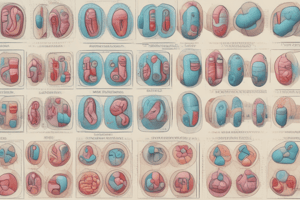Podcast
Questions and Answers
What is the primary concern with the development of carbapenem-resistant Acinetobacter baumannii (CRAB) strains?
What is the primary concern with the development of carbapenem-resistant Acinetobacter baumannii (CRAB) strains?
- The limited number of novel fluoroquinolone classes for clinical use
- The nephrotoxicity of quinolones
- The emergence of multidrug resistance in CRAB strains (correct)
- The increased use of quinolones in clinical practice
What is the characteristic of quinolones in terms of their killing effect?
What is the characteristic of quinolones in terms of their killing effect?
- Concentration-dependent and time-independent
- Concentration- and time-dependent (correct)
- Dose-dependent and time-independent
- Dose-independent and time-dependent
Why are fluoroquinolones being reused as potential drugs in human body therapy?
Why are fluoroquinolones being reused as potential drugs in human body therapy?
- In combination with other drugs and physiological weakness (correct)
- Due to their concentration-dependent killing effect
- Due to their nephrotoxicity
- Because of their limited availability
What is the classification of quinolones by the World Health Organization?
What is the classification of quinolones by the World Health Organization?
What is the limitation of the available quinolones in treating CRAB infections?
What is the limitation of the available quinolones in treating CRAB infections?
What is the reason for the reuse of quinolones in clinical practice?
What is the reason for the reuse of quinolones in clinical practice?
What is the evolutionary transformation of Acinetobacter baumannii that is particularly common?
What is the evolutionary transformation of Acinetobacter baumannii that is particularly common?
What is the primary goal of the present study?
What is the primary goal of the present study?
What is the primary mechanism of action of aminoglycosides against gram-negative bacteria?
What is the primary mechanism of action of aminoglycosides against gram-negative bacteria?
What is the primary concern with using aminoglycosides in combination with beta-lactam antibiotics for CRAB infections?
What is the primary concern with using aminoglycosides in combination with beta-lactam antibiotics for CRAB infections?
What is the primary reason for the development of new antibiotic compounds for CRAB infections?
What is the primary reason for the development of new antibiotic compounds for CRAB infections?
What is the primary mechanism of resistance of Acinetobacter baumannii to antimicrobial agents?
What is the primary mechanism of resistance of Acinetobacter baumannii to antimicrobial agents?
What is the primary goal of the study mentioned in the content?
What is the primary goal of the study mentioned in the content?
What is the primary outcome of using quinolones and aminoglycosides in CRAB-infected patients?
What is the primary outcome of using quinolones and aminoglycosides in CRAB-infected patients?
What is the primary advantage of using TGC and CAZ/AVI treatment in CRAB-infected patients?
What is the primary advantage of using TGC and CAZ/AVI treatment in CRAB-infected patients?
What is the estimated annual number of deaths in the U.S. due to bacterial infections acquired during hospital stays?
What is the estimated annual number of deaths in the U.S. due to bacterial infections acquired during hospital stays?
What is the primary concern with the widespread outbreaks of CRAB infections?
What is the primary concern with the widespread outbreaks of CRAB infections?
What is the primary outcome of using quinolones in CRAB-infected patients?
What is the primary outcome of using quinolones in CRAB-infected patients?
What is the primary reason for the urgent need to launch new effective antibiotics?
What is the primary reason for the urgent need to launch new effective antibiotics?
What is the challenge in treating CRAB infections?
What is the challenge in treating CRAB infections?
What was the primary aim of the study mentioned in the content?
What was the primary aim of the study mentioned in the content?
What is CRAB?
What is CRAB?
What was the outcome of the study compared to previous studies?
What was the outcome of the study compared to previous studies?
What is the significance of the widespread dissemination of carbapenem-resistant genes?
What is the significance of the widespread dissemination of carbapenem-resistant genes?
What is the primary mechanism of resistance to antibiotics in Acinetobacter baumannii?
What is the primary mechanism of resistance to antibiotics in Acinetobacter baumannii?
What is the optimal temperature range for the growth of Acinetobacter baumannii?
What is the optimal temperature range for the growth of Acinetobacter baumannii?
What is the characteristic that allows Acinetobacter baumannii to protect itself from effector molecules?
What is the characteristic that allows Acinetobacter baumannii to protect itself from effector molecules?
What is the only antimicrobial that Acinetobacter baumannii is unable to produce resistance against innately?
What is the only antimicrobial that Acinetobacter baumannii is unable to produce resistance against innately?
What is the mechanism of action of aminoglycosides in treating gram-negative infections?
What is the mechanism of action of aminoglycosides in treating gram-negative infections?
What is the significance of using a nitrofurantoin with aminoglycosides in treating gram-negative infections?
What is the significance of using a nitrofurantoin with aminoglycosides in treating gram-negative infections?
What is the characteristic of Acinetobacter baumannii that allows it to form biofilms on abiotic and biotic surfaces?
What is the characteristic of Acinetobacter baumannii that allows it to form biofilms on abiotic and biotic surfaces?
What is the bacterium described as a strictly aerobic, Gram-negative, coccobacillus, non-fermentative and non-motile?
What is the bacterium described as a strictly aerobic, Gram-negative, coccobacillus, non-fermentative and non-motile?
What is the derivative of quinolines used as antimicrobial agents?
What is the derivative of quinolines used as antimicrobial agents?
What is the characteristic that allows Acinetobacter baumannii to use a variety of compounds as sources of carbon, nitrogen, sulfur, and phosphorus?
What is the characteristic that allows Acinetobacter baumannii to use a variety of compounds as sources of carbon, nitrogen, sulfur, and phosphorus?
What characterizes Multidrug-resistant Acinetobacter baumannii (MDR-AB)?
What characterizes Multidrug-resistant Acinetobacter baumannii (MDR-AB)?
What is the main difference in action between quinolones and aminoglycosides?
What is the main difference in action between quinolones and aminoglycosides?
What was the primary objective of the study mentioned in the content?
What was the primary objective of the study mentioned in the content?
What was the finding of the study regarding the 28-day mortality in the subgroup of blood infection?
What was the finding of the study regarding the 28-day mortality in the subgroup of blood infection?
What is a potential advantage of quinolones over aminoglycosides?
What is a potential advantage of quinolones over aminoglycosides?
What was the result of the ciprofloxacin plus amikacin treatment in the study?
What was the result of the ciprofloxacin plus amikacin treatment in the study?
Why do clinicians prefer to use quinolones over aminoglycosides?
Why do clinicians prefer to use quinolones over aminoglycosides?
What is the significance of carbapenem resistance in A. baumannii infections?
What is the significance of carbapenem resistance in A. baumannii infections?
What is a limitation of the use of quinolones in treating CRAB infections?
What is a limitation of the use of quinolones in treating CRAB infections?
What is the ultimate goal of the review mentioned in the content?
What is the ultimate goal of the review mentioned in the content?
What type of organisms are quinolones especially effective against?
What type of organisms are quinolones especially effective against?
What is the mechanism of carbapenem-resistance in Acinetobacter?
What is the mechanism of carbapenem-resistance in Acinetobacter?
What is the function of OprD in Acinetobacter?
What is the function of OprD in Acinetobacter?
What is the purpose of the study comparing quinolones and aminoglycosides in CRAB infections?
What is the purpose of the study comparing quinolones and aminoglycosides in CRAB infections?
What is the result of the absence of OprD in Acinetobacter?
What is the result of the absence of OprD in Acinetobacter?
What is the mechanism of resistance caused by OXA-23 in Acinetobacter?
What is the mechanism of resistance caused by OXA-23 in Acinetobacter?
What is the result of the increase in carbapenem-resistant Acinetobacter baumannii infections?
What is the result of the increase in carbapenem-resistant Acinetobacter baumannii infections?
What is the common feature of the four quinolones mentioned in the study?
What is the common feature of the four quinolones mentioned in the study?
What is the significance of Tn2006 and Tn2008 in carbapenem-resistance?
What is the significance of Tn2006 and Tn2008 in carbapenem-resistance?
What is the result of the overuse of carbapenem in hospital patients?
What is the result of the overuse of carbapenem in hospital patients?
Flashcards are hidden until you start studying
Study Notes
Carbapenem-Resistant Acinetobacter Baumannii (CRAB) Infections
- CRAB is an opportunistic pathogen commonly found in hospitals, resistant to most antibiotics, and causes hospital-acquired pneumonia, postoperative wound infections, and various infections in patients with low immunity and trauma.
- CRAB is a high outbreak infectious agent that can cause serious infections and has significant economic pressure on hospitals and patients.
Quinolones and Aminoglycosides
- Quinolones are essential medicines recognized by the World Health Organization, have a concentration- and time-dependent killing effect, and are not nephrotoxic.
- Aminoglycosides inhibit bacterial protein synthesis, cause a bactericidal effect against gram-negative bacteria, and are often administered in combination with beta-lactams for CRAB infections.
Mechanisms of Action and Spectrum of Activity
- Quinolones are especially effective against gram-negative organisms and have a broad antibacterial spectrum, inhibiting bacterial DNA synthesis.
- Aminoglycosides are bactericidal against gram-negative organisms, including Escherichia coli, Klebsiella species, and Pseudomonas aeruginosa.
Mechanisms of Carbapenem-Resistance
- Plasmid-mediated resistance is a widespread phenomenon, and the overuse of carbapenem can cause carbapenem to undergo highly restricted clinical treatment.
- The main mechanism of carbapenem-resistance in Acinetobacter is the production of carbapenem-hydrolyzing class D enzymes, such as OXA-23, OXA-24, and OXA-58.
Clinical Studies Comparing Quinolones and Aminoglycosides
- A study evaluated the clinical efficacy of quinolones and aminoglycosides in patients with CRAB infections, including 702 patients in the quinolones group and 411 in the aminoglycosides group.
- Quinolones can penetrate cells more easily than aminoglycosides and have a higher efficacy than aminoglycosides in combinations.
Key Findings and Outcomes
- Quinolones and aminoglycosides have relatively potent broad-spectrum activity against diverse bacterial species, but quinolones are a better choice for serious infections due to less nephrotoxicity or ototoxicity.
- The study found no significant differences between quinolones and aminoglycosides in tested outcomes in the overall population or the subgroup of pneumonia.
Conclusion and Future Directions
- The resistance rates to quinolones have increased, but quinolones are still a better choice for serious infections, especially when combined with amikacin.
- The development of new effective antibiotics is urgently needed to overcome the infection burden of CRAB infections.
Studying That Suits You
Use AI to generate personalized quizzes and flashcards to suit your learning preferences.




